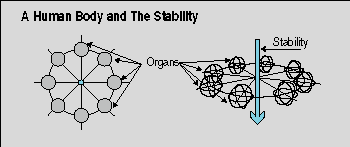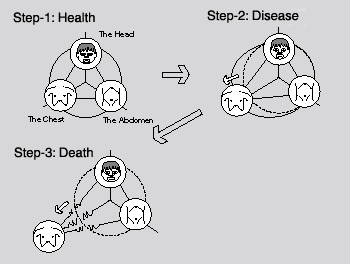 |
 |
|
|
|
 |
VII. Death
Consider theoretically what condition forces a human body to die. |
|
|
|
|
1. Definition of Death
Death can theoretically be defined as follows: when a human body loses the stability completely, it cannot maintain the structure; as a result, it dies. Although this definition differs completely from that of modern medical science, it can easily be deduced from analyzing theoretically the macroscopic structure in a human body.
2. Stability of A Human Body
A human body maintains the life on the basis of the stability, which originates in the balance among organs. In a human body, each of organs, as explained many times, always balances itself with other organs. This balance works as the stability, which allows a human body to live. This mechanism is quite the same as that an atom has, because a human body and an atom are relative systems in nature. |
|
|
|

|
|
|
|
3. Death
When a human body completely loses the stability, it will die. Usually before a human body completely loses the balance among the organ, it causes disease to neutralize the imbalance. However, even when a human body causes disease to neutralize the imbalance and in addition does not obtain the stability enough to live, it cannot maintain the life anymore; then, this human body will die. |
|
|
|

|
|
|
|
4. Theoretical Analysis of Death
Next, let us apply this mechanism to the structure of an actual human body. A human body is created as a nest of units. The largest unit is a human body itself. The secondary-largest units are the head, the chest, and the abdomen. Furthermore, the balance among these three secondary-largest units plays a major role in whether a human body can maintain the life or not. For instance, when a human body completely loses the balance between the head and other two secondary-largest units: the chest and the abdomen, it will die. Likewise, also when a human body completely loses the balance between the chest and other two secondary-largest units, it also will die. The figure below shows this mechanism. (A human body lives on the basis of very-simple mechanisms, because very-simple mechanisms easily allow a human body to live as long as possible.) |
|
|
|

|
|
(Step-1: A human body in Good Health. Step-2: A human body loses the balance between the chest and other two secondary-largest units: the head and the abdomen; then, it causes disease to neutralize the imbalance. Step-3: When a human body completely loses the balance among the chest and other two secondary-largest units, it will die because of the instability.) |
|
|
|
5. Importance of Analyzing Macroscopic Mechanisms
Fix in your mind that in a human body, the macroscopic mechanisms have the ability to control the microscopic mechanisms. The majority of medical researchers and doctors tend to think that all the mechanisms in a human body depend only upon the microscopic mechanisms such as cellular functions and genetic functions. However, they should notice that macroscopic functions in a human body can control microscopic functions. In other words, an organ is not only controlled by a gene and by the metabolic function, but also can control a gene and the metabolic function. In fact, we will never find out the fundamental cause of disease without paying attention to the macroscopic mechanisms in a human body. |
|
|
|